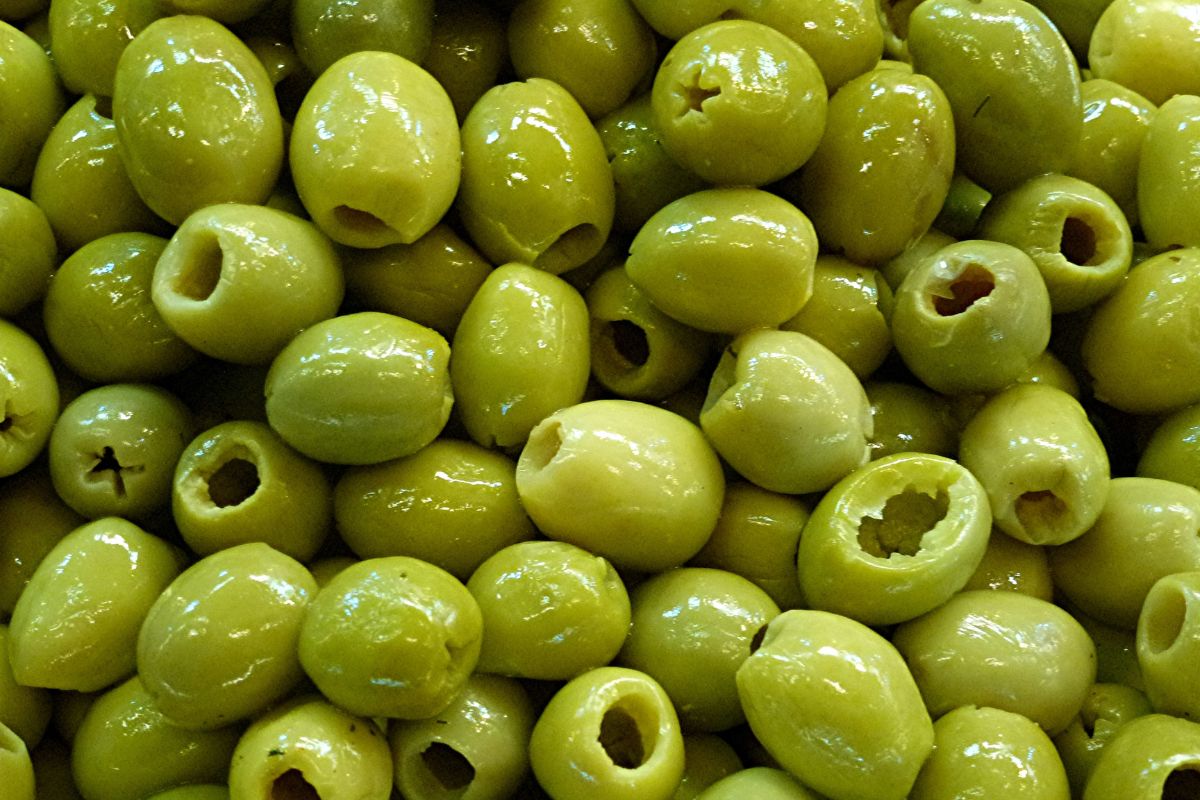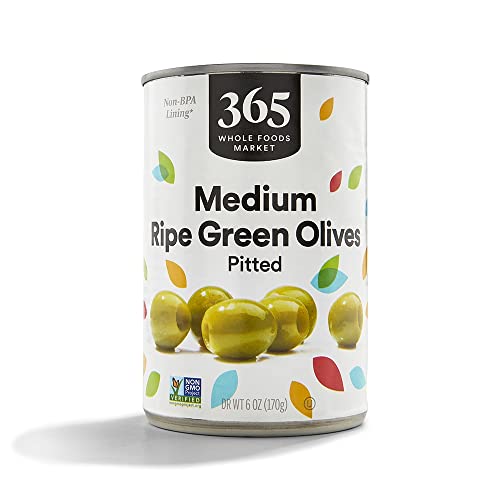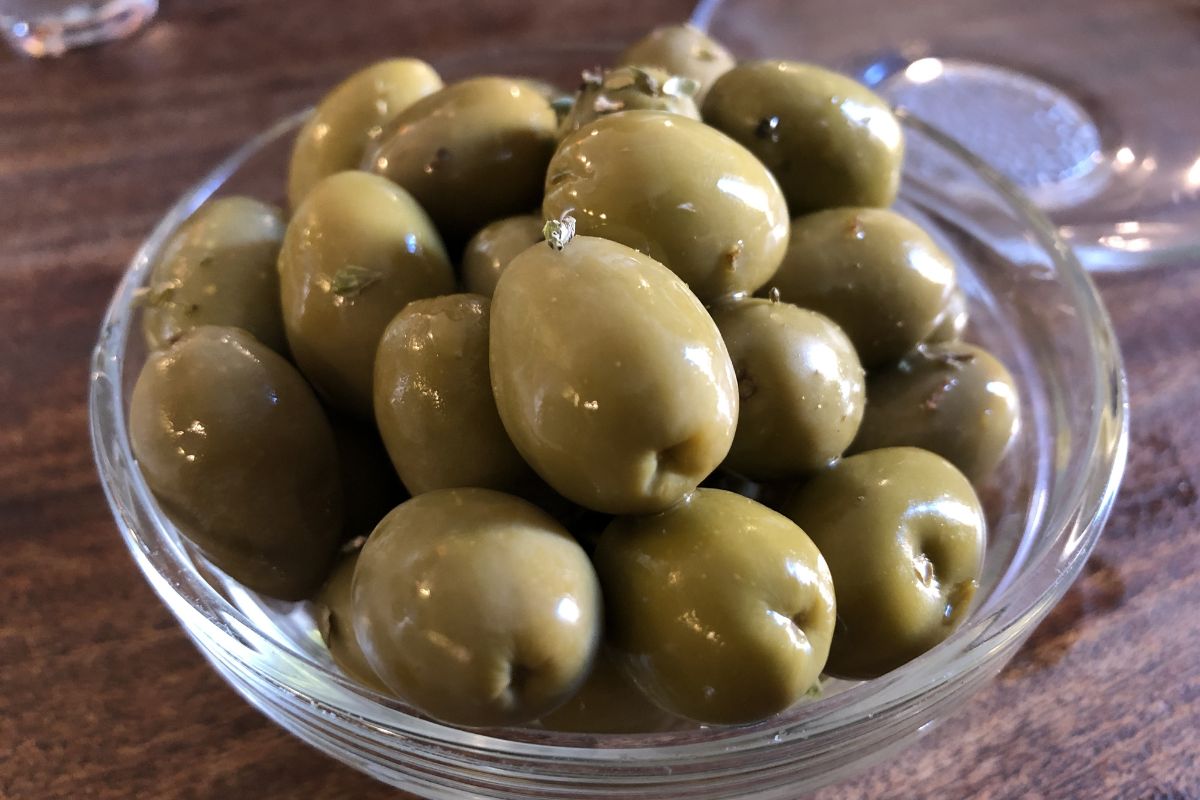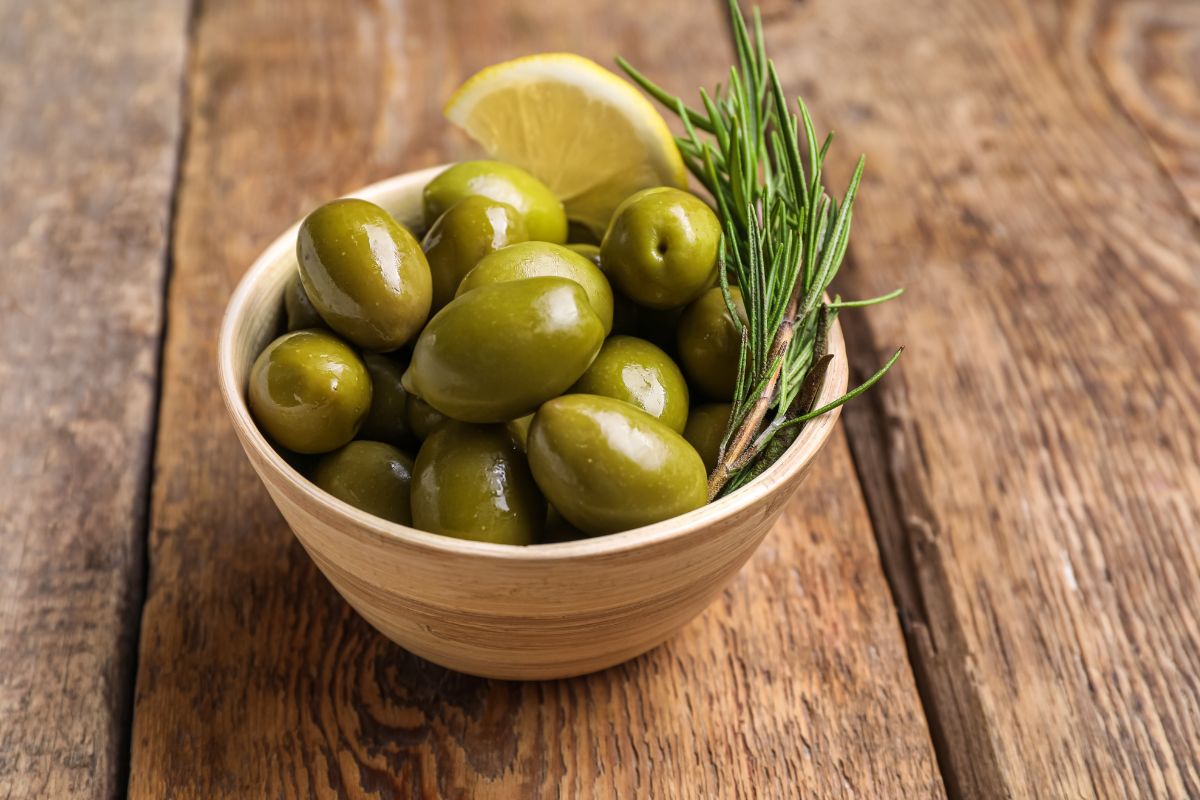What are Green Olives?
Green olives are unripe olive fruits with a green tint. You can eat the best green olives after processing. The raw black olives taste way too bitter compared to ripe black olives.
In most cases, people produce olive oil from green olives. Before pickling them in oil, olive oil producers soak the fresh olives in lye. However, green olives can last longer, and you can eat them later with meals.

Our Top Pick
Our best green olives are the 365 by Whole Foods Market. These olives have a rich olive taste and are not bitter.
The Best Green Olives at a Glance
- 365 by Whole Foods Market: Best overall
- Whole Foods Market, Organic Garlic Stuffed Olives: Best organic
- Pearls Olives To Go!, Pimiento Stuffed, Spanish Green Olives: Best gluten-free
- Roland Foods Whole Castelvetrano Olives: Best mild flavor
- Mario Camacho Foods Pitted Snack Olives, Seasoned Green Garlic Olives: Best for snacking






Our Green Olives Reviews
365 by Whole Foods Market: Best Overall
Brand: Whole Foods Market
Recommended uses: Every occasion
Package information: Olives, water, salt.
Weight: 6 ounces (170 grams)
Pitted: Yes
Flavor/s: Natural
About This Item
This product’s packaging features a brand-new, modern appearance. You might receive the old or new packaging in your order during this transition, but the product and quality will remain the same.
These ripe green olives are brimming with rich olive taste yet are not bitter like many types of olives. Manzanilla olives, which the Spanish brought to California over 200 years ago, are the only ones the company hand-picks.
Due to the traditional ripening method, which preserves the olive’s rich flavor and firm texture, each olive displays the natural coloration of the ripe green stage.
The product has a BPA-free lining and is Kosher-certified and GMO-free.
Whole Foods Market, Organic Garlic Stuffed Olives: Best Organic
Brand: Whole Foods Market
Recommended uses: Snacking
Weight: 4.23 ounces (119.9 grams)
Pitted: No
Flavor/s: Natural
About This Item
This Whole Foods Market brand has you covered when it comes to cutting-edge tastes and products sourced from artisans and producers around the world. Amazing products, top-notch components, and no concessions.
The product is organic and vegan-certified.
Pearls Olives To Go!, Pimiento Stuffed, Spanish Green Olives: Best Gluten-Free
Amazon’s Choice for “Pearls Olives to Go”
Brand: Pearls
Recommended uses: Every occasion
Weight: 1.6 ounces (45.3 grams)
Pitted: No
Flavor/s: Natural
About This Item
Pearl olives improve upon what is already great. And nothing beats these stuffed green olives, which are firm, crisp, and tasty. Pearls olives are ideal for every occasion since they are carefully chosen by professionals and grown under the warm Mediterranean sun.
The product is always non-GMO, gluten-free, cholesterol-free, and kosher. It gives an excellent, zesty taste to any meal or the ideal snack.
Their delightfully salty and nutty flavor makes for a tasty snack or lunchtime pick-me-up.
Roland Foods Whole Castelvetrano Olives: Best Mild Flavor
Amazon’s Choice for “Roland Olives”
Brand: Roland Foods
Recommended uses: Snacking
Weight: 4.9 ounces (138.9 grams)
Pitted: Yes
Flavor/s: Natural sea salt
About This Item
This product may add a traditional taste of green Italian olives to your meal. These large pitted green olives from Sicily are a popular snacking olive in Italy and worldwide.
They have a mild flavor and are not overly salty, making them an excellent option for food lovers who steer clear of stronger olive varieties. These imported Italian green olives provide enough servings for both commercial and household kitchen use, and it is ready to consume right away.
Slice them up into salads and stews, serve them as an appetizer before dinner, or eat them all day as a nutritious snack.
Since 1934, Roland Foods’ multifaceted team of seasoned chefs, food enthusiasts, and logistical experts has brought together individuals worldwide to explore their shared passion for food. They import more than 1,500 goods from the Middle East, North Africa, Europe, South America, and Asia.
Mario Camacho Foods Pitted Snack Olives, Seasoned Green Garlic Olives: Best for Snacking
Amazon’s Choice for “Mario Olives”
Brand: Mario Camacho
Recommended uses: Snacking
Weight: 1.05 ounce (29.7 grams)
Pitted: Yes
Flavor/s: Garlic, kalamata, natural sea salt black olives, natural sea salt green olives, savory pepper
About This Item
This is the best green olives to eat if you like trying out flavors. This product has different flavors like garlic, kalamata, natural sea salt, and savory pepper.
This is a product of Mario Camacho Foods. They develop novel goods with excellent packaging. They consider environmental sustainability, corporate social responsibility, and making constant advancements to offer goods and services of the utmost caliber.
What You Can do With Green Olives
Due to their high sodium level, green olives have a salty, savory flavor that lends to various culinary applications. You can eat green olives on their own, add them to salads or pasta dishes, make them into a tapenade, or use it as a garnish for olive martinis.
The olive tree, found in the Mediterranean, tropical and central Asia, and some regions of Africa, produces olives as a fruit. Researchers discovered olive seeds 8,000 years ago in Spain, and there is archaeological proof that different types of olives grow as crops as early as 2500 BCE.
You must process olives before eating since they are too bitter when raw. Typically, this involves curing or pickling the olives. People convert the majority of olives into olive oil, although they preserve some and use them in food, particularly in Mediterranean cuisine.
Green olives are olives that are not fully ripe. They soak in lye before adding oil, contributing to their distinctive flavor.
Health Advantages
Olives have a distinct flavor that is bitter and salty. But they are also highly healthful and make a great addition to your meals. Olives are low in cholesterol and rich in nutrients that support your body’s health despite their high sodium content. Some of the health advantages of eating green olives include the following:
May Reduce Heart Disease Risk
Olive consumption dominates Mediterranean diets. According to studies, women who follow a Mediterranean diet are considerably less likely to acquire heart disease.
The low cholesterol content of olives, which relates to heart disease, may be one explanation. The fact that olives are a rich source of monounsaturated fats, which the American Heart Association demonstrates can enhance heart health, provides another argument.
Lessen Persistent Inflammation
Rheumatoid arthritis and psoriasis are only a few illnesses greatly influenced by chronic inflammation. Olives may lessen chronic inflammation, easing the signs and symptoms of this and other ailments.
It contains antioxidants, which are abundant in olives and reduce chronic inflammation. In animal tests, hydroxytyrosol and oleanolic acid, two types of antioxidants present in olives, successfully lowered inflammation.
Oleanolic acid positively affects animal health, including lowering inflammation, boosting liver health, and controlling blood fat levels.

Some Reader Questions Answered
How Many Different Types of Olives are There?
People have been eating farmed olives and harvesting the drupes for oil for the past 6,000 years. In reality, archaeologists have discovered a wealth of evidence on the eastern shore of the Mediterranean basin that suggests olives were among the earliest fruit plants for domestic use.
Since then, the cultivation of olive trees has spread to other parts of the Mediterranean basin, partly due to the efforts of Phonecian traders who introduced the trees to Tuscany, Andalusia, and Tunisia, which are now known for their production of table olives and olive oil.
Today, olives are grown in numerous nations on all continents, save Antarctica. The International Olive Council has calculated that 90 percent of harvested olives will make oil. Table olives are from the remaining 10% of the olive crop.
The two most common varieties of olives, black and green, are common to most casual consumers. But all olives start green and gradually turn into light brown and reddish-purple hues before fully maturing and becoming dark black.
According to the IOC, 139 olive types produced in 23 nations produce around 85% of all olives consumed worldwide.
Each cultivar of olives has distinctive chemical and flavor traits of its own. However, due to differences in cultivation, harvesting, and processing, oils from the same cultivar might differ.
Monovarietal or monocultivar olive oil is from one type of olive. You can create blends using oils from two or more cultivars.
Here are some details about a handful of the most popular types used as table olives and in oil.
Picual
A recent study found that Picual olives account for nearly one-third of the world’s production of olive oil. This is due to the high oil content, between 20 and 27 percent, of Picual olives.
Picual varietals have a high concentration of polyphenols when made into virgin or extra-virgin olive oil. Though only around 25 percent of the farmed Picual olives convert into virgin or extra virgin olive oil, that percentage is increasing as it continues to garner accolades on a global scale.
The production of most Picual olives is from the province of Jaén in Andalusia. However, this hardy cultivar is flourishing globally in diverse locations, including California, New Zealand, and Egypt.
Arbequina
Arbequina olives, a native type of Catalonia, are the second most frequently utilized variety of olives in the manufacture of olive oil, after Picual.
Arbequina olives are common in mechanical harvesting operations because of their small, uniform drupe size. Their appeal among producers is largely because of their high oil content and flexibility.
Arbequina olives are useful as table olives and a popular oil variety. Because of their relatively low polyphenol content, they have a milder, butterier flavor that many customers find appealing.
Hojiblanca
Hojiblanca olives, which have their origins in the southern Spanish region of Cordoba, are the third most popular cultivar after Picual and Arbequina.
Farmers love hojiblanca trees for their hardiness (they can withstand cold and drought) and for their huge olives, which have an oil production of 17 to 19 percent.
Hojiblanca oil has a distinct flavor with a sweet initial taste and a harsh aftertaste. Hojiblanca olives are particularly well-liked as table olives since they have a lower oil content than the predominant Picual and Arbequina kinds.
Leccino
One of the most well-known cultivars in Italy is the leccino olive, which has a long history and several advantageous production characteristics.
Leccino olives originate in Tuscany because the variety first appears in medieval literature. The cultivar, with an average oil production of 18 to 21%, is currently widely grown in northern and central Italy, flourishing in the milder climate of the peninsula’s hilly and mountainous center.
Under the right circumstances, leccino trees grow swiftly and yield a lot, making them popular with growers in Italy, Chile, Australia, and California.
Frantoio
Frantoio olives are another well-known Italian cultivar for the production of olive oil. They are also native to the Tuscany region in central Italy. Frantoio trees thrive in moderate climates and are more resistant to excessive heat and cold than other types.
These three types have led to the global exportation of Frantoio olives, which are now grown for commerce on six continents.
Coratina
Coratina olives are among the most widely grown in Italy, along with the Leccino and Frantoio types. The olives are extremely versatile and come from Puglia in southern Italy.
Coratina olives are cultivars that are successful in various locations because of their versatility. However, the type is only frequently grown in Italy because the olives’ irregular shape makes picking more challenging.
Coratina trees produce large, rounded olives with up to a 25% oil yield. The oil is popular for its high concentration of polyphenols and other antioxidants and for being generally robust and bitter.
Kalamata
The Kalamata olive is one of the most well-known table olive kinds and is native to the southwest of the Peloponnese peninsula. Greek olives are traditionally huge; you can only pick when they are fully mature and are dark purple or black.
The olives are usually preserved in wine vinegar or olive oil and are famous as meaty due to the quantity of flesh and relatively low oil content (approximately 7%). You can never harvest the olives while still green; instead, they are hand-picked once they have become black.
The term “Kalamata olive” only refers to olives from the Greek area of Kalamata in the European Union and several other nations with which it has trade agreements.
Koroneiki
The predominant oil type in Greece is the Koroneiki olive, which you can farm on the mainland and the numerous islands that make up the nation. Between 50 and 60 percent of Greece’s olive-growing land is for Koroneiki.
Koroneikis are excellent candidates for intensive (high-density mechanical) harvesting, along with the Arbequina and Picual types. Koroneiki olives are consequently grown in 19 different nations worldwide.
The oils from Koroneiki olives typically have a bitter and potent flavor due to their high polyphenol and oleocanthal content.
Cobrancosa
Cobrancosa olives are one of Portugal’s most well-known types, making up around 10% of the nation’s total olive-growing land.
The Cobrancosa olive tree is extremely fruitful. Cobrancosa olives have a medium size and produce oil with a characteristic strong, spicy, and bitter flavor.
Despite being primarily farmed in the country’s steep Tras-os-Montes region, Cobrancosa olives have already expanded to other parts of the nation.
Mission
Mission olives, the national olive of the United States, were originally cultivated in California following the arrival of Franciscan missionaries in San Diego Bay in 1769. There would be 21 more missions built in California during the following 50 years, each with its olive grove.
With around 8% of California’s total olive-growing land, Mission olives are still one of the state’s most popular. Mission olives make up around half of the table olives made in California.
Small drupes from mission trees result in milder butter oil. Mission olives are generally table olives, brined before or dried after ripening.
What is the Difference Between Black and Green Olives?
When it comes to packaged green and black olives, there are other identifying qualities in addition to the difference in their degree of maturity. Green olives sold in bottles are always pitted and filled with various ingredients, such as pimentos, almonds, anchovies, jalapenos, onions, or capers.
Small black olives in cans weigh between 0.112 and 0.116 ounces (3.2 and 3.3 grams) each. Other sizes include medium, big, extra-large, jumbo, colossal, and super colossal. Additionally, black olives have more oil than green olives do.
The time it takes to cure olives varies depending on the technique utilized. While brining requires the greatest fermentation period, lye curing is the fastest. You can brine ripe black olives immediately, but green olives must first steep in a lye solution. The olive’s flavor will grow less bitter and more complex if you allow it to ferment in its brine.
What are the Different Types of Green Olives?
There are numerous green olives types, but your neighborhood grocery or specialty grocer might only carry a few. Spanish green olives known as Manzanillas are delicately lye-cured before packing in a brine of salt and lactic acid.
The Gordal is a different Spanish olive that translates to “fat one,” which is an appropriate name for this hefty, spherical green olive. You can serve as a tapas, and they have a deep, meaty flavor.
Picholine olives are green olives cured in salt brine and have a subtle and somewhat briny flavor. In some cases, they use citric acid in the United States as a preservative in these products.
Cerignola, located in Italy, is the center of production for a green olive variety with the same name. It is large, possesses a flavor reminiscent of butter, and is crisp to the touch.

What Do Green Olives Taste Like?
Olives and people get along strangely. You either eat olives, or you can’t tolerate the sight of them; there is no in-between. No matter whose side you’re on, there’s no denying that the olives have a flavor all their own. They are unlike anything else and go well with every recipe in the cookbook.
Olives can have diverse flavors based on their size, shape, color, fermentation, and curing processes. You’ll frequently hear the phrase “fresh olives” when you visit a supermarket.
Due to how bitter they are, you’ll likely need to rinse your mouth after eating fresh olives, black or green. Additionally, this is different from those acquired flavors you gradually like. Before consumption, you must preserve a freshly plucked olive in salt or brine.
Oleuropein, a phenolic substance, is the cause of this. Oleuropein levels in fresh olives can reach up to 14%, along with other bitter compounds. Olives need fermentation and curing to be edible. By removing the unpleasant oleuropein, this procedure also releases other metabolites that improve the flavor.
Unripe green olives have a sharper, tangier flavor than black olives because they have more salt and less oil.
Green olives often stay in a solution of fresh lemon juice and seawater after fermentation. White vinegar, olive leaves, and rosemary are ingredients in certain recipes. As a result, green olives have a zesty undertone that balances out their bitterness. Try Lebanese or Phenician olives if you want to sample green olives with a zesty flavor.
The most popular variety of green olives might be Spanish olives. They produce over 60% of the green olives grown worldwide. They lack a zesty flavor but are less bitter than green olives.
Olive curing turns an olive’s natural sugars into lactic acid, which is more closely related to fermentation. You can remove oleuropein and phenols, which have a strong flavor, from fruit in one of five ways:
- Brine-curing: Fully matured, dark purple or black olives gradually ferment in brine during brine-curing (i.e., salt water). This can take a year or more. Since the brine serves to amplify the fruit’s natural qualities, brine-cured olives are frequently sweet and flavorful.
- Water-curing: This procedure is the slowest and is hence not mostly used. It involves soaking, rinsing in plain water, and repeating the process several times. Some producers start the curing process with their olives in a water bath and then transfer them to seasoned brine.
- Dry-curing: For a month or more, these olives stay in salt. The salt draws out the bitterness and moisture from the olives. After the salt is out, the olives may occasionally receive an olive oil bath to maintain them juicy and plump. The flavor of dry-cured olives is strong, and they have a wrinkled, prune-like look.
- Lye-curing: This time- and money-efficient technique is popular with large commercial olive growers. The method originates in Spain and involves submerging raw olives in alkaline lye solution vats. Unfortunately, the fast-acting lye also reduces the flavor of the olive, producing a sad, flavorless olive with a slightly chemical aftertaste.
- Sun/air curing: You can occasionally ferment olives on the branch or, after picking, by soaking up the sun. An olive allowed to cure on the tree is the Thrubolea variety from Crete.
Wrapping Things Up
It’s challenging to utilize green and black olives interchangeably due to their distinct flavors. You can swap out black olives for green ones when serving fresh olives as a snack or starter. But if a recipe specifies a certain sort of olive, it probably takes into account the particular flavor characteristics of that olive.
If black olives must replace green olives, attempt to cook them for a shorter amount of time so they keep more of their taste. Cook them to lessen some of the bitterness of green olives.
However, you must adjust the salt in your recipe to consider the saltiness of green olives. Try out your recipe with our top pick: 365 by Whole Foods Market.

Community of passionate writers and content creators who share a love for Italian heritage, culture, travel, food, and the Italian-American community. Our mission is to celebrate Italy’s rich history and traditions and connect with others who share the same passion.







